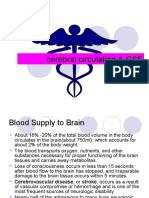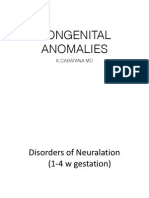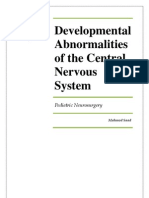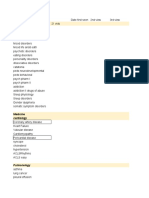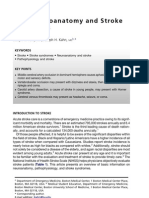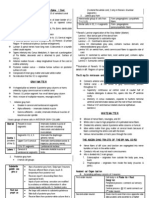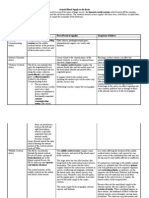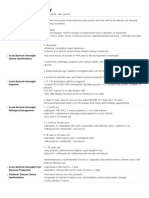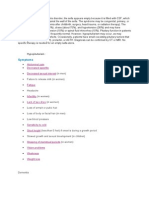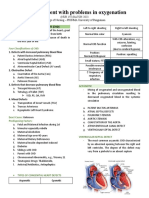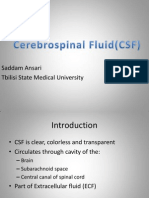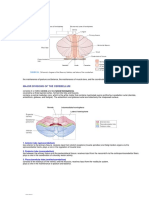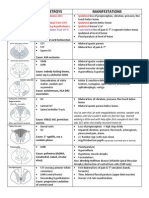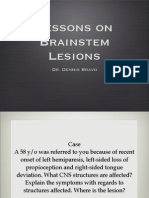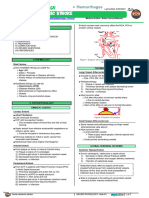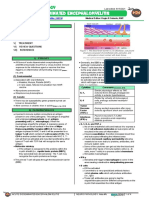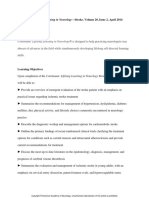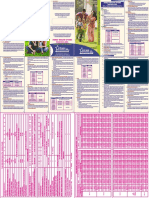Acute Ischemic Stroke: Etiology, Pathophysiology, Clinical Features, Diagnostics, Treatment
Acute Ischemic Stroke: Etiology, Pathophysiology, Clinical Features, Diagnostics, Treatment
Uploaded by
Afrah AbdulCopyright:
Available Formats
Acute Ischemic Stroke: Etiology, Pathophysiology, Clinical Features, Diagnostics, Treatment
Acute Ischemic Stroke: Etiology, Pathophysiology, Clinical Features, Diagnostics, Treatment
Uploaded by
Afrah AbdulOriginal Title
Copyright
Available Formats
Share this document
Did you find this document useful?
Is this content inappropriate?
Copyright:
Available Formats
Acute Ischemic Stroke: Etiology, Pathophysiology, Clinical Features, Diagnostics, Treatment
Acute Ischemic Stroke: Etiology, Pathophysiology, Clinical Features, Diagnostics, Treatment
Uploaded by
Afrah AbdulCopyright:
Available Formats
Last edited: 8/20/2021
1. ACUTE ISCHEMIC STROKE
Acute Ischemic Stroke: Etiology, Pathophysiology, Clinical Medical Editor: Adara Garcia Maestu
Features, Diagnostics, Treatment
Embolic causes most commonly affect the MCA, PCA or
OUTLINE smaller cortical vessels
I) EPIDEMIOLOGY
II) PATHOPHYSIOLOGY
III) STROKE SYNDROMES / SYMPTOMS BY
VASCULAR TERRITORY
IV) DIAGNOSIS
V) TREATMENT
VI) COMPLICATIONS
VII) REVIEW QUESTIONS
VIII) REFERENCES
EPIDEMIOLOGY Figure 1 Diagram demonstrating the origin of paradoxical and
cardiac emboli
Risk Factors
Non-modifiable (things you can’t fix) THROMBOTIC CAUSES
o Age ≥ 65
o Males > Females Large Vessel Atherosclerosis
o African American or Hispanic ethnicity Caused by above risk factors
o Family History of cardiovascular/cerebrovascular o Esp. HTN, DM, HLD, smoking and age
disease
Pathophysiology:
Modifiable (things you can fix) 1) Plaque in vessel wall ruptures
o Hypertension (HTN) 2) Thrombus develops over plaque decreasing lumen
o Diabetes Mellitus (DM) 3) Decreased blood flow beyond thrombus
o Atherosclerosis or Hyperlipidemia (HDL) 4) Ischemia → Infarction
o Obesity
o Tobacco, drug and alcohol abuse Most common sites:
o ICA after bifurcation of common carotid artery
Due to carotid stenosis
I) PATHOPHYSIOLOGY o Vertebrobasilar System
o Stem of the MCA or just prior to its first bifurcation
EMBOLIC CAUSES
Cardiac Emboli
Atrial Fibrillation
Left ventricular thrombus Figure 2 Rupture of a plaque
CHF with low ejection fraction Small Vessel Atherosclerosis
o This increases stasis of blood flow and risk of clots
forming Same causes and pathophysiology as large vessel
atherosclerosis (see above)
Septic emboli from infective endocarditis vegetations on
Most common sites:
mitral or aortic valve
o Lenticulostriate vessels:
o Could be tricuspid in intravenous drug users
These supply basal ganglia, internal capsule and
Fibrinous material on mitral or aortic valves from corona radiata
rheumatic heart disease o Small pontine penetrating vessels
Mechanical heart valve (highly thrombogenic)
Arterial Emboli GLOBAL CEREBRAL ISCHEMIA
From plaque on Aortic or Internal Carotid Artery Systemic Hypoperfusion
Plaque or piece of it is dislodged
Embolus gets stuck in downstream cerebral vessel Due to cardiogenic, obstructive or septic shock
Decreased blood flow beyond embolism 1) Decrease in Mean Arterial Pressure (MAP)
Ischemia → Infarction 2) ↓ cerebral perfusion and oxygen delivery (ischemia)
3) Infarction of watershed areas
Paradoxical Emboli
Watershed areas refers to regions of the brain
From DVT in patients with Patent Foramen Ovale (PFO)
situated furthest away from supplying blood vessels.
or Atrial Septal Aneurysm
Because of this, they are the most susceptible to
Thrombus dislodges and enters RA via IVC
infarction due to low blood pressure!
Moves to LA/PFO or septal aneurysm
Enters LV, then aorta and ICA
Risk is increased in the setting of concomitant carotid
Embolus gets stuck in downstream cerebral vessel
stenosis (further reduces cerebral flow)
Decreased blood flow beyond embolism
Ischemia → Infarction
Acute ischemic stroke NEURO PATHOLOGY: Note #1. 1 of 7
Severe and Prolonged Hypoxia II) STROKE SYNDROMES / SYMPTOMS BY VASCULAR
Occurs in acute respiratory failure TERRITORY
1) Decreased oxygen content in blood due to
ventilation-perfusion (V/Q) mismatch
2) ↓ oxygen delivery to the brain despite adequate (A) ANTERIOR CIRCULATION STROKES
perfusion These account for roughly 70% of strokes
3) Infarction of watershed areas
Middle Cerebral Artery (MCA) stroke
In a cardiopulmonary arrest, a mixture of hypoperfusion This is the most common type of stroke
(heart is not pumping) and hypoxia (lungs aren’t drawing in The MCA supplies:
air) results in very likely infarction and stroke if not o Lateral portions of frontal and parietal lobes
corrected o Superior part of the temporal lobe
o Basal Ganglia
OTHER CAUSES
Hypercoagulable States Superior division infarct
Diseases that cause clots to form (usually venous) May damage the following structures:
Inherited thrombophilias o Primary Motor Cortex (lateral portion)
o Factor V Leiden Contralateral weakness or paralysis of upper
o Antithrombin III deficiency limbs, face and upper trunk
o Protein C and S deficiency o Primary somatosensory cortex (lateral portion)
o Prothrombin gene mutation Contralateral sensory loss of upper limbs, face
and upper trunk
Acquired thrombophilias o Frontal eye field
o Antiphospholipid Syndrome Ipsilateral gaze deviation
o Heparin induced Thrombocytopenia (HIT) o Broca’s area
Polycythemia Broca’s (Expressive) aphasia (can understand but
not speak)
Vasculitis
Causes Inferior division infarct
o Autoimmune May damage the following structures:
Giant Cell Arteritis o Wernicke’s area
Takayasu’s Arteritis Wernicke’s (Receptive) aphasia (can speak but
o Infectious not understand)
Tuberculosis o Optic radiations
Syphilis Contralateral homonymous hemianopia or
Varicella Zoster Virus quadrantanopia without macular sparing
o Primary CNS Vasculitis
Infarct of the MCA on the non-dominant side
Pathophysiology
1) Inflammation of the lining of blood vessels causes (Usually right side) can result in damage to the following
endothelial dysfunction structures:
2) Dysregulation of clotting system leads to o Right parietal and temporal lobe
increased risk of clots Apraxia → Difficulty performing voluntary actions
3) Ischemia → Infarction despite intact motor function and desire to
OR perform movement
1) Inflammation of the lining of blood vessels causes Hemieglect → Unaware of visual or somatic
narrowing of the lumen sensations on contralateral side of the body
2) Decreased blood flow in cerebral vessels
Anterior Cerebral Artery (ACA) stroke
(ischemia)
3) Infarction The ACA supplies:
o Medial portions of frontal and parietal lobes
Arterial Dissection
o Basal Ganglia
Causes An infarct may damage the following structures:
o Trauma
o Fibromuscular Dysplasia (i) Primary motor cortex (medial portion)
o Connective tissue diseases
o Contralateral weakness or paralysis of lower limbs
Marfan’s Syndrome
and lower trunk
Ehlers Danlos Syndrome
Pathophysiology (ii) Primary somatosensory cortex (medial portion)
1) Tear within the vessel wall (tunica intima) o Contralateral sensory loss of lower limbs and trunk
2) Blood moves in between tunica intima and tunica
media dissecting them (iii) Paracentral lobule of parietal lobe
3) Collection of blood bulges into the lumen, o Urinary incontinence
narrowing it o Fecal incontinence
4) Ischemia → Infarction
(iv) Prefrontal cortex and anterior cingulate cortex
o Abulia→ Decreased motivation to perform tasks
o Akinetic mutism
Occurs in bilateral frontal lobe infarcts
Severe decreased motivation to perform tasks
Figure 1 Arterial Dissection No response to pain
2 of 7 NEURO PATHOLOGY: Note #1. Acute ischemic stroke
Catatonic Vertebral Artery + PICA
(v) Anterior/superior frontal lobe Vertebral Artery gives off:
o Anterior Spinal Artery (ASA)
o Transcortical motor aphasia→ Similar to Broca’s Supplies medial medulla
aphasia but maintain the ability to repeat phrases o Posterior Inferior Cerebellar Artery (PICA)
Internal Carotid Artery (ICA) stroke Supplies lateral medulla and posterior inferior
cerebellum
The ICA supplies both the MCA and ACA, therefore a
mixture of both these stroke syndromes’ symptoms can
be seen with a severe ICA infarct Infarct of vertebral artery/ASA
In 5% of patients it ICA infarct can cause PCA stroke
May damage the following structures:
syndrome due to fetal variant
o CN XII nucleus
ICA also supplies the retina and infarct may cause:
Ipsilateral tongue deviation
o Amaurosis Fugax→ Transient ipsilateral mono-ocular
o Medial Lemniscus
vision loss that may become permanent if not treated Contralateral sensory loss of whole side
• Proprioception
Lenticulostriate Arteries • Fine touch
• Vibrations
Small arterial branches off the MCA that supply
o Corticospinal tracts in pyramids before decussation
subcortical and brainstem structures
Contralateral weakness or paralysis of whole side
An infarct damages the posterior limb of the internal
capsule and other basal ganglia resulting in various
lacunar stroke syndromes: Infarct of PICA (Wallenburg Syndrome)
Pure Motor Stroke May damage the following structures:
o Contralateral weakness of whole side o Inferior cerebellar peduncles
Sensorimotor Stroke Ipsilateral ataxia→ Impaired co-ordination and
o Contralateral weakness of whole side balance
o Contralateral sensory loss/paresthesia of whole side o Nucleus Ambiguus (CN IX, X, XI)
Ataxic Hemiparesis Dysphagia
o Ipsilateral weakness and ataxia Hoarseness
Vocal cord paralysis (dysphonia)
Dysarthria (clumsy hand syndrome) Diminished cough and gag reflexes
o Contralateral weakness of face and hand Contralateral uvular deviation
o Dysarthria o Vestibular nuclei
Pure Sensory Stroke Nausea and Vomiting
o Contralateral sensory loss/paresthesia of whole side Vertigo
Nystagmus
o Descending Sympathetic Tracts
III) POSTERIOR CIRCULATION STROKES Ipsilateral Horner’s syndrome (Ptosis, Miosis,
Anhidrosis)
These account for roughly 30% of strokes
o Spinal Trigeminal Nucleus (CN V)
Posterior cerebral artery (PCA) Ipsilateral sensory loss of face
• Pain
The PCA supplies:
• Temperature
o Midbrain
o Spinothalamic Tract
o Occipital lobes
Contralateral sensory loss of the whole side
o Posteromedial region of temporal lobe
o Thalamus • Pain
• Temperature
An infarct may damage the following structures:
(i) Occipital lobe Basilar artery + AICA
o Homonymous Hemianopia with macular sparing Basilar artery gives off:
o Paramedian branches
(ii) Thalamus
Supply medial pons
o Variable/contralateral sensory loss or paresthesia of o Superior Cerebellar Artery
whole side o Anterior Inferior Cerebellar Artery (AICA)
o Visual field cut (damage to lateral geniculate nucleus) Supply lateral pons
o Decreased arousal or coma
(iii) Midbrain Infarct of paramedian arteries
o Weber Syndrome May cause damage to the following structures:
Ipsilateral CN III palsy o CN VI (Abducens) nucleus
Contralateral hemiplegia Ipsilateral loss of eye abduction
o Claude Syndrome Medial gaze deviation
Ipsilateral CN III palsy o Medial Longitudinal Fasciculus (MLF)
Contralateral ataxia Internuclear ophthalmoplegia→ Inability to co-
o Benedikt Syndrome ordinate eye movements
Combination of Weber and Claude syndromes o Paramedian Pontine Reticular Formation (PPRF)
Loss of ipsilateral gaze
o Medial Lemniscus
Acute ischemic stroke NEURO PATHOLOGY: Note #1. 3 of 7
Contralateral loss of fine touch, proprioception and CT angiogram of head and neck
vibration o Filling defects
o Corticospinal tract o Vessel cutoffs
Contralateral weakness o Large vessel occlusions
12 lead ECG
Infarct of AICA o To assess for any acute MI or arrythmias
(AFib/Aflutter) as potential causes
May cause damage to the following structures:
Labs
o Middle Cerebellar Peduncles
o POC glucose
Ipsilateral Ataxia→ Impaired co-ordination and
Rule out hypoglycemia as stroke mimic
balance
o Don’t delay treatment to obtain the following unless
o Vestibular Nucleus
there is concern or your institution requires it per
Vertigo
protocol:
Nausea and Vomiting
CBC
Nystagmus
• Asses for severe anemia, suggestive of
o Cochlear Nuclei
bleeding which can contraindicate TPA
Decreased hearing
Tinnitus • Assess for severe thrombocytopenia (<100k)
o Descending Sympathetic tracts which may affect TPA administration
Horner’s Syndrome (Ptosis, Anhidrosis, Miosis) • Polycythemia as possible cause for occlusion
o CN V (trigeminal) nucleus + tract Coagulation Studies
Ipsilateral loss of sensation to face • INR > 1.7
Loss of ipsilateral corneal reflex o Check if they take Warfarin or have liver
Ipsilateral mastication muscle weakness failure which can contraindicate TPA
o Spinothalamic Tracts Etiology/Risk factors workup
Contralateral loss of pain and temperature on
whole side Transthoracic/Transesophageal echocardiogram
o CN VII (facial) nucleus o Assess for atrial or ventricular thrombi
Ipsilateral facial weakness (usually lower part) o Assess for valve vegetations or mechanical valve
o Assess for low EF or wall motion abnormalities
o Assess for PFO or atrial defect
WATERSHED INFARCTS Can further evaluate with TCD bubble study
Infarcts of watershed areas→ Regions of the brain Check if bubbles cross atria and float up to
situated furthest away from supplying blood vessels cerebral circulation
o Found where two vascular territories anastamose CT angiogram, MR angiogram or Carotid Doppler
Most susceptible to infarction during low perfusion states o Assess aortic and carotid circulation for stenosis or
(↓ BP) dissections
o Assess for intracranial atherosclerosis
MCA / ACA watershed zone infarct MRI
Contralateral weakness/paralysis and sensory loss of o Assess stroke burden and rule out other etiology
upper and lower extremities Diffusion-weighted imaging (DWI) shows up bright
Also known as “Man in a Barrel” Syndrome when infarction present
Apparent Diffusion Coefficient (ADC) shows up
MCA / PCA watershed zone infarct dark when infarction present
Visual dysfunctions T2 flair shows cytotoxic edema when infarction
o Prosopagnosia→ Patient sees objects/people but present
can’t make out what/who they are Holter Monitor
o Homonymous Hemianopia o Assess for any paroxysmal atrial fibrillation or flutter
o Balint’s Syndrome (rare)
Labs
Simultanagnosia→ Inability to perceive more than
o Lipid panel to assess for hyperlipidemia
one object at a time Eg. Patient will see individual
o Hemoglobin A1c to assess for DM
trees but is unable to recognize the forest
o TSH with reflex to assess for hyperthyroidism which
Optic ataxia→ Lack of co-ordination between
can cause AFib
visual input and hand movements Eg. Patient
o Hypercoagulable workup if patient young with history
touches their own nose but struggles to touch the
of DVT and no apparent etiology
physician’s finger
Factor V
Oculomotor apraxia→ Inability to shift gaze
Protein C and S
voluntarily despite desire to do so and intact
Antithrombin III activity
function of extraocular muscles
Prothrombin activity
Antiphospholipid antibodies
IV) DIAGNOSIS
• Cardiolipin, lupus anticoagulant and beta
ACUTE WORKUP glycoprotein
PF4 antibodies + serotonin release assay if
Imaging suspect HIT
STAT non-contrast CT of the head o ESR, CRP, ANA panel, ANCA to assess for vasculitis
o Rule out intra-cranial hemorrhage (ICH) and sub- (low on differential
arachnoid hemorrhage (SAH) o VDRL, RPR to rule out syphilis and PCR for VZV as
o Analyze for early ischemic changes: causes of infectious vasculitis (low on differential)
Hyperdense MCA / Basilar artery where the clot is NIHSS Assessment
Hypodensity of brain tissue (infarction) within 3
hours of stroke Tool to assess stroke severity and predict outcomes
4 of 7 NEURO PATHOLOGY: Note #1. Acute ischemic stroke
11 categories with scores ranging from 0 to 42 o DOACs preferred by patients because there is no
No strict cutoff for IV TPA although some research need to monitor INR weekly
suggests NIHSS >4 Hold anticoagulation if:
Don’t memorize- Use MD calc or other Tool Kits o Infective endocarditis is a cardioembolic cause
o In large hemispheric stroke infarcts for 2-4 weeks
V) TREATMENT
after stroke due to high risk of hemorrhagic
ACUTE TREATMENT OF STROKE transformation
Intravenous TPA Antiplatelet Therapy
Mechanism of action: Indications:
o TPA→ ↑ plasmin formation→ ↑ fibrin degradation o Post stroke
o History of coronary artery disease with stents
from clot→ Breakdown of clot
Aspirin or clopidogrel used for non-embolic strokes 24-
Indications:
48hrs after stroke
o Acute neurological deficit
o Last known well < 3hrs Percutaneous closure of PFO/atrial defect
OR
If <60 y/o with cryptogenic strokes
o Last known well < 4.5hrs if:
Patient is 18 or older Carotid Revascularization Procedures
NIHSS is lower than 25
Carotid Endarterectomy (CEA)
There is no history of DM or previous stroke
o Indications:
Affected area on scan is < 1/3 of MCA territory
Symptomatic Carotid Stenosis >70%
o No ICH or SAH on CT
Symptomatic Carotid Stenosis <70% if older male
o No active bleeding
o No recent anticoagulation Carotid Artery Stenting
o Preferred over CEA when high risk of periprocedural
Dosage:
complications
o 0.9mg/kg
o 10% given as a bolus Risk Factor Modifications
o Remaining given over the next hour
Hypertension
Monitoring post IV-TPA: o Antihypertensives optimized or started
o Blood pressure <185/110 for 24hrs
Lower BP with nicardipine or labetalol Diabetes
o Neuro checks o Insulin / oral antidiabetic medications optimized or
Every 15 mins for 1st hour started
Every 30 mins for next 6 hours Hyperlipidemmia
Every hour for 24hrs o Statins optimized or started
o CT scan 24hrs after administration Smoking cessation
Assess any hemorrhagic transformation Weight loss in obese patients
Evaluate any evolution of infarct
Give the okay to start anticoagulation if needed VI) COMPLICATIONS
Mechanical Thrombectomy
Cerebral Edema/Elevated ICP
Interventional radiology procedure using real time
Usually peaks 3-5 days post infarct of large MCA territory
imaging to thread a catheter or stent retriever into
o Infarct→ cytotoxic edema→ Midline shift→ ↑ ICP→
affected vessel and remove clot
Herniation risk
Indications:
o Large vessel occlusion Treatment Options:
Proximal MCA o Decompressive Hemicraniectomy
ICA terminus o ICP supportive measures:
Vertebral and Basilar arteries Keep neck midline
o Last known well between 6-24hrs (earlier preferred) Elevate head of bed 30 degrees
o Salvageable penumbra Reduce agitation and pain
Use CT or MR perfusion studies to identify o Sedation and intubation if ICP not controlled with
CT aspects score > 6 supportive measures
• Determines benefit of procedure Propofol drip (decreases basal metabolic rate and
cerebral blood flow leading to reduced ICP)
TREATMENT FOR PREVENTION o Hypertonic Agents
Anticoagulation 23.4% hypertonic saline with emergent ICP crisis if
central line is present
Indications: 25% mannitol with emergent ICP if peripheral IV
o Atrial Fibrillation Prophylaxis of cerebral edema with continuous
o LV or LA thrombus infusion of 3% hypertonic saline to a goal of 150-
o Mechanical heart valve 155
o CHF with reduced EF
o Cerebral venous sinus thrombosis with venous infarct
o Hypercoagulable disorder
Heparin drip or lovenox as a bridge to warfarin or DOACs
for long term control
o Heparin is easy to titrate while in hospital
o Warfarin superior to DOACs with mechanical valves
and AFib secondary to mitral stenosis
Acute ischemic stroke NEURO PATHOLOGY: Note #1. 5 of 7
Post TPA complications Ischemic strokes also carry risk of causing nonconvulsive
status epilepticus
Hemorrhagic Conversion
o Can only be proven by continuous EEG
o Suspect with acute neuro change
o Obtain CT to confirm Treatment options:
o Treatment options: o Levetiracetam
Stop TPA if still running o Valproate
Reverse TPA if <12-24hrs after infusion o Phenytoin or fosphenytoin
• Tranexamic Acid (TXA)
Aspiration Pneumonia
• Cryoprecipitate
• Platelet transfusion if needed Stroke→ Dysphagia→ Inability to clear secretions
properly→ aspiration→ ↑Risk of pneumonia
Requires proper speech evaluation to determine if patient
can eat/drink or requires a feeding tube
If pneumonia develops:
o Antibiotics against pathogen from sputum cultures
Angioedema
o TPA can cause allergic reaction of lips and larynx
o Treatment options:
Antihistamines
IV steroids
Low threshold for intubation
Seizures
Ischemic infarcts can become a focus of epileptogenic
potential leading to focal seizures with risk of generalizing
VII) SUMMARY TABLE
Table 1-1 Stroke Syndromes Summary Table
Vessel Symptoms Vessel Symptoms
Contralateral weakness/paralysis and sensory Ataxia
loss of upper limbs, face and upper trunk Dysphagia, Dysphonia, ↓ gag and cough
Ipsilateral gaze deviation PICA reflexes
MCA Aphasia (expressive, receptive or both) (Lateral Contralateral uvular deviation
Contralateral Homonymous hemianopia Medulla) Vertigo, N/V, Nystagmus
without macular sparing Ipsilateral Horner’s Syndrome
Apraxia + Hemineglect if infarct on non- Loss of pain and temperature on ipsilateral
dominant hemisphere face and contralateral whole side
Contralateral weakness/paralysis and sensory
loss of lower limbs and lower trunk Vertebral Contralateral weakness/paralysis and sensory
Urinary and fecal incontinence Artery/ASA loss (fine touch, vibration + proprioception) of
ACA
Abulia or Akinetic mutism (Medial whole side
Transcortical motor aphasia (able to repeat Medulla) Ipsilateral tongue deviation
phrases)
Ataxia
Vertigo, N/V, Nystagmus
Hearing loss + tinnitus
Mixture of MCA and ACA symptoms AICA Ipsilateral Horner’s Syndrome
ICA May have PCA symptoms if fetal variant (Lateral Ipsilateral loss of sensation to face, loss of
present Pons) corneal reflex and weakness of mastication
Amaurosis Fugax
and facial muscles
Contralateral loss of pain and temperature on
whole side
Homonymous Hemianopia with macular
Basilar Contralateral weakness and loss of fine touch,
sparing
Artery proprioception and vibration
PCA Variable or contralateral sensory
(Medial Ipsilateral loss of eye abduction→ Medial gaze
loss/paresthesia of whole side (thalamus)
Pons) deviation
Weber, Claude or Benedikt Syndromes
Intranuclear ophthalmoplegia
(midbrain)
6 of 7 NEURO PATHOLOGY: Note #1. Acute ischemic stroke
VIII) REVIEW QUESTIONS IX) REFERENCES
● Parvathaneni A, M Das J. Balint Syndrome. [Updated 2021 Jun
1) Which is the most important modifiable risk factor
30]. In: StatPearls [Internet]. Treasure Island (FL): StatPearls
for strokes? Publishing; 2021 Jan-. Available from:
a. High BMI https://www.ncbi.nlm.nih.gov/books/NBK544347/
b. Low exercise levels ● Bickley LS, Szilagyi PG, Hoffman RM, Soriano RP, Bates B.
Bates' Guide to Physical Examination and History Taking.
c. Hypertension Philadelphia: Wolters Kluwer; 2021.
d. Cigarette smoking ● Longmore JM. Mini Oxford Handbook of Clinical Medicine.
Oxford: Oxford University Press; 2015.
2) Which of the following is a stroke symptom? ● Sabatine MS. Pocket Medicine: the Massachusetts General
a. Sudden confusion Hospital Handbook of Internal Medicine. Philadelphia: Wolters
b. Sudden weakness in an arm or leg Kluwer; 2020.
● Williams DA. Pance Prep Pearls. Middletown, DE: Kindle Direct
c. Sudden severe headache with no cause Publishing Platform; 2020.
d. Sudden trouble seeing ● Jameson JL, Fauci AS, Kasper DL, Hauser SL, Longo DL,
e. All of the above Loscalzo J. Harrison's Principles of Internal Medicine. New York
etc.: McGraw-Hill Education; 2018.
3) Which of the following is characteristic of an ACA ● Cucchiara BL, Messé SR. Antiplatelet therapy for secondary
prevention of stroke. In: Post TW, ed. UpToDate .
stroke?
● Schur PH, Kaplan AA. Treatment of antiphospholipid syndrome.
a. Ataxia In: Post TW, ed. UpToDate
b. Intranuclear ophthalmoplegia ● The Pocket Guide to Neurocritical Care: A Concise Reference
c. Ipsilateral tongue deviation for the Evaluation and Management of Neurologic Emergencies.
Chicago, IL: Neurocritical Care Society; 2017.
d. All of the above ● Westover MB, DeCroos EC, Awad KM, Bianchi MT. Pocket
Neurology. Philadelphia: Wolters Kluwer; 2016.
4) Damage to which of these structures is associated ● Lee K. The NeuroICU Book. New York: McGraw-Hill Education;
with urinary incontinence? 2018.
a. Paracentral lobule of parietal lobe ● Louis R Caplan. Overview of the Evaluation of Stroke. In: Post
b. Midbrain TW, ed. UpToDate.
● Powers WJ, Rabinstein AA, Ackerson T, et al. Guidelines for the
c. Anterior/Superior frontal lobe Early Management of Patients With Acute Ischemic Stroke: 2019
d. None of the above Update to the 2018 Guidelines for the Early Management of Acute
Ischemic Stroke: A Guideline for Healthcare Professionals From the
5) Patients suffering from Wernicke’s Aphasia can American Heart Association/American Stroke Association. Stroke
understand what it is said to them. .2019; 50(12).
● Le T, Bhushan V, Skelley N. First Aid for the USMLE Step 2 CK.
a. True McGraw-Hill Education; 2012
b. False ● Kleindorfer DO, Towfighi A, Chaturvedi S, et al. 2021 Guideline
c. Depends on the patient for the Prevention of Stroke in Patients With Stroke and Transient
Ischemic Attack: A Guideline From the American Heart
6) Which of the following is the most appropriate first Association/American Stroke Association. Stroke .2021
test for a query stroke? ● Caplan LR, Kasner SE, Dashe JF. Etiology, Classification, and
Epidemiology of Stroke. In: Post TW, ed. UpToDate .
a. 12-lead ECG
b. Head and neck MRI
c. Non-contrast head CT
d. Coagulation studies
CHECK YOUR ANSWERS
Acute ischemic stroke NEURO PATHOLOGY: Note #1. 7 of 7
You might also like
- Hiv Awareness Project ProposalDocument17 pagesHiv Awareness Project ProposalPrincess Gesa Macula100% (1)
- Spina BifidaDocument27 pagesSpina BifidaSandy VillarNo ratings yet
- Knee Pain Secret RemediesDocument36 pagesKnee Pain Secret RemediesVAIBHAV PHULARE75% (4)
- Increased ICP: A) HeadacheDocument5 pagesIncreased ICP: A) Headachemohamed nagyNo ratings yet
- Blood Suppy of BrainDocument54 pagesBlood Suppy of BrainZoya MoraniNo ratings yet
- Extra Aksial Brain TumorsDocument15 pagesExtra Aksial Brain TumorsPPDSNeuroUnsri RSMH0% (1)
- CNS Pathology Fall 2009Document106 pagesCNS Pathology Fall 2009EllagEszNo ratings yet
- Embryologic DefectsDocument62 pagesEmbryologic DefectsBenjamin AgbonzeNo ratings yet
- CSF & Body FluidDocument42 pagesCSF & Body FluidlopaNo ratings yet
- Neuropathology: FK UisuDocument28 pagesNeuropathology: FK UisuAnggi WahyuNo ratings yet
- Developmental Cns AnomaliesDocument37 pagesDevelopmental Cns AnomaliesMhmod Saad100% (1)
- Cardiac MurmursDocument28 pagesCardiac MurmursAlvin BlackwellNo ratings yet
- Kidney TumorsDocument15 pagesKidney TumorsJose SirittNo ratings yet
- Cerebellar DisordersDocument12 pagesCerebellar DisordersAnn SamNo ratings yet
- OnlineMedEd Clinical Video ListDocument8 pagesOnlineMedEd Clinical Video ListCourtney Holbrook100% (1)
- Meninges, Ventricles - CSF - Study GuideDocument3 pagesMeninges, Ventricles - CSF - Study Guideshivani patelNo ratings yet
- Chapter 19 Pediatric Diseases and DisordersDocument5 pagesChapter 19 Pediatric Diseases and DisordersCelestine Kate Audi ٿNo ratings yet
- Anat 6.3 GSA Appendix - EsguerraDocument4 pagesAnat 6.3 GSA Appendix - Esguerralovelots1234No ratings yet
- Basic Neuroanatomy and Stroke Syndromes PDFDocument15 pagesBasic Neuroanatomy and Stroke Syndromes PDFFrancisco A. Villegas-López100% (2)
- Pathology of Peripheral Nerve and Skeletal Muscle - DADocument46 pagesPathology of Peripheral Nerve and Skeletal Muscle - DASinta Dewi AdityaniNo ratings yet
- Neuro Tract Lesions Ps230114Document16 pagesNeuro Tract Lesions Ps230114সোমনাথ মহাপাত্রNo ratings yet
- CVA or StrokeDocument14 pagesCVA or StrokeJoenalyn AliguinNo ratings yet
- Cerebellar LesionsDocument3 pagesCerebellar LesionsMary100% (1)
- Embryology Reviewer Chapter 1 and 2Document9 pagesEmbryology Reviewer Chapter 1 and 2Allison Eunice ServandoNo ratings yet
- STROKEDocument61 pagesSTROKEK.MERCYNo ratings yet
- (NEURO) 006 SEIZURES-and-EPILEPSYDocument16 pages(NEURO) 006 SEIZURES-and-EPILEPSY3BBEGILJUDY ANNBNo ratings yet
- Approach To A Case of Respiratoey SystemDocument105 pagesApproach To A Case of Respiratoey SystemprashuNo ratings yet
- Ascending Tracts Neuro AnatomyDocument2 pagesAscending Tracts Neuro AnatomyrachellesliedeleonNo ratings yet
- MS Myasthenia Gravis Gillian-Barre Syndrome Parkinson's: Ascending Reversible ParalysisDocument5 pagesMS Myasthenia Gravis Gillian-Barre Syndrome Parkinson's: Ascending Reversible ParalysishaxxxessNo ratings yet
- A Clinical Approach To SyncopeDocument8 pagesA Clinical Approach To Syncopepuskesmas tarik100% (1)
- Normal Pressure HydrocephalusDocument59 pagesNormal Pressure Hydrocephalusrys239No ratings yet
- GI Anatomy & EmbryoDocument19 pagesGI Anatomy & EmbryoMaya LaPradeNo ratings yet
- Kathynotes PDFDocument103 pagesKathynotes PDFvarrakeshNo ratings yet
- Anastomosis Left Anterior Cerebral Artery BlockageDocument5 pagesAnastomosis Left Anterior Cerebral Artery BlockagemcwnotesNo ratings yet
- Disease of Nervous System Lect 2Document62 pagesDisease of Nervous System Lect 2Monirul IslamNo ratings yet
- Cerebrospinal Fluid CSF Analysis and InterpretatioDocument6 pagesCerebrospinal Fluid CSF Analysis and InterpretatioIoana CucuNo ratings yet
- NeuroDocument48 pagesNeurokandeeNo ratings yet
- Anti-Epileptic DrugsDocument2 pagesAnti-Epileptic DrugsKaoriMarieSembranoNo ratings yet
- Patof Spell PDFDocument3 pagesPatof Spell PDFAnggi CalapiNo ratings yet
- Anatomy and Physiology of Blood VesselDocument3 pagesAnatomy and Physiology of Blood Vesselneleh grayNo ratings yet
- Empty Sella SyndromeDocument2 pagesEmpty Sella Syndromewawan_291289100% (1)
- Embryology and Development of KidneyDocument75 pagesEmbryology and Development of Kidneyranjitha sraateNo ratings yet
- Congenital Heart DefectsDocument6 pagesCongenital Heart DefectsJohiarra Madanglog TabigneNo ratings yet
- Cerebrospinal CSFDocument31 pagesCerebrospinal CSFRashid MohamedNo ratings yet
- B4 DyspneaDocument100 pagesB4 DyspneaAnonymous HH3c17osNo ratings yet
- CerebellumDocument14 pagesCerebellumapi-508474347No ratings yet
- Cns Neurological ExaminationDocument26 pagesCns Neurological ExaminationDr.P.NatarajanNo ratings yet
- MigraineDocument9 pagesMigraineRose Athena SibalaNo ratings yet
- Ring Enhancing LesionsDocument50 pagesRing Enhancing LesionsVivek Gupta100% (1)
- Approach To SyncopeDocument38 pagesApproach To SyncopeNurhafizah IbrahimNo ratings yet
- Neonatal Seizures 2024Document12 pagesNeonatal Seizures 2024Víctor CalzadaNo ratings yet
- MBR 2019 - CNS Pathology HandoutDocument6 pagesMBR 2019 - CNS Pathology HandoutNica Lopez FernandezNo ratings yet
- Brainstem StrokesDocument4 pagesBrainstem StrokesChandniNo ratings yet
- Acute Ischaemic StrokeDocument40 pagesAcute Ischaemic StrokeDana Crusoveanu100% (1)
- Disease Destroys Manifestations: Spinothalamic Tract (STT) ContralateralDocument3 pagesDisease Destroys Manifestations: Spinothalamic Tract (STT) ContralateralRenata V CNo ratings yet
- Brainstemlesions 100119022243 Phpapp02Document107 pagesBrainstemlesions 100119022243 Phpapp02Andrei ChyzhNo ratings yet
- Pulmonary Arterial Hypertension in Congenital Heart Disease: Eisenmenger’s Syndrome - A Global PerspectiveFrom EverandPulmonary Arterial Hypertension in Congenital Heart Disease: Eisenmenger’s Syndrome - A Global PerspectiveNo ratings yet
- Stroke and HemorrhagesDocument12 pagesStroke and Hemorrhagespbffdnw7xfNo ratings yet
- Acute Ischemic Stroke - Etiology, Pathophysiology, Clinical Features, Diagnostics, Treatment AtfDocument7 pagesAcute Ischemic Stroke - Etiology, Pathophysiology, Clinical Features, Diagnostics, Treatment AtfArnoldNo ratings yet
- Cerebrovascular AccidentDocument53 pagesCerebrovascular AccidentJulia Salvio50% (2)
- Medial Lemniscus Pathway: Ascending Tracts Dorsal ColumnDocument4 pagesMedial Lemniscus Pathway: Ascending Tracts Dorsal ColumnAfrah AbdulNo ratings yet
- Abducens Nerve Cranial Nerve VI AtfDocument4 pagesAbducens Nerve Cranial Nerve VI AtfAfrah AbdulNo ratings yet
- Acute Disseminated Encephalomyelitis ADEM AtfDocument4 pagesAcute Disseminated Encephalomyelitis ADEM AtfAfrah AbdulNo ratings yet
- Open Folder 07. NeurologyDocument5 pagesOpen Folder 07. NeurologyAfrah AbdulNo ratings yet
- Intracameral Mydriatics Versus Topical Mydriatics in Pupil Dilation For Phacoemulsification Cataract SurgeryDocument5 pagesIntracameral Mydriatics Versus Topical Mydriatics in Pupil Dilation For Phacoemulsification Cataract SurgeryGlaucoma UnhasNo ratings yet
- PKPADocument22 pagesPKPAYola SafitriNo ratings yet
- General Practitioner: Medical ServiceDocument1 pageGeneral Practitioner: Medical ServiceArdiNo ratings yet
- Vol 20.2 - Cerebrovascular Disease.2014 PDFDocument229 pagesVol 20.2 - Cerebrovascular Disease.2014 PDFpuskesmas tarikNo ratings yet
- CiticolineDocument2 pagesCiticolineFrudz OrjalezaNo ratings yet
- About SleepDocument71 pagesAbout SleepAnnisa Kurnia HastutiNo ratings yet
- Become Healthy or Extinct by Darryl DsouzaDocument281 pagesBecome Healthy or Extinct by Darryl DsouzaDip Dip DipNo ratings yet
- 4Document1 page4DrRizwanellahiNo ratings yet
- VAMA Poster2Document1 pageVAMA Poster2CEDIVA DeniaNo ratings yet
- NurseDocument6 pagesNurseMikaela CasimiroNo ratings yet
- Disseminated Intravascular Coagulation in Infants and ChildrenDocument40 pagesDisseminated Intravascular Coagulation in Infants and Childrenkabulkabulovich5No ratings yet
- Alcohol .PPT 2015Document17 pagesAlcohol .PPT 2015EmperatrizPachecoHuamaniNo ratings yet
- Mola Hidatidosa JESDocument24 pagesMola Hidatidosa JESmember12dNo ratings yet
- Culala Joseph Khen P. Med SheetDocument6 pagesCulala Joseph Khen P. Med SheetjomariNo ratings yet
- Air Leak Syndrome: Signs and SymptomsDocument2 pagesAir Leak Syndrome: Signs and SymptomsSheila Rose SalesNo ratings yet
- Family Health Optima Insurance PlanDocument4 pagesFamily Health Optima Insurance PlanAnuj GargNo ratings yet
- Research On Anxiety Disorders/DepressionDocument6 pagesResearch On Anxiety Disorders/DepressionJohanne ArribeNo ratings yet
- David D. Burns - WikipediaDocument16 pagesDavid D. Burns - WikipediacamicrisNo ratings yet
- PHD ThesisDocument74 pagesPHD ThesisEngrAbeer ArifNo ratings yet
- CPR AED PowerPointDocument106 pagesCPR AED PowerPointrajesh.880889No ratings yet
- Daftar Harga ObatDocument5 pagesDaftar Harga Obatbella.ramadantiNo ratings yet
- Immediate Loading of Dental Implants PDFDocument15 pagesImmediate Loading of Dental Implants PDFAmar Bimavarapu100% (2)
- 4 Lecture Notes Urology 6th Edition by Amir Kaisary and John BlandyDocument11 pages4 Lecture Notes Urology 6th Edition by Amir Kaisary and John Blandyapi-237463278No ratings yet
- Submaximal Exercise Testing PTJ 2000Document28 pagesSubmaximal Exercise Testing PTJ 2000ashlyn granthamNo ratings yet
- DR ABC - Basic First Aid Occupational Health and SafetyDocument6 pagesDR ABC - Basic First Aid Occupational Health and SafetyRinor Mujaj100% (1)
- Reuben Drug Classes and Actions NsaidsDocument2 pagesReuben Drug Classes and Actions NsaidsKarinaKarinaNo ratings yet
- Melia-Arisanti, N. K., Sumarya, I M., Arsana, I N. Program Studi Biologi Fakultas Teknologi Dan Sains Universitas Hindu Indonesia EmailDocument8 pagesMelia-Arisanti, N. K., Sumarya, I M., Arsana, I N. Program Studi Biologi Fakultas Teknologi Dan Sains Universitas Hindu Indonesia EmailAhmad Hibban AwriyaNo ratings yet
- ASSESSMENT REPORT For Melilotus Officinalis (L.) Lam., HerbaDocument38 pagesASSESSMENT REPORT For Melilotus Officinalis (L.) Lam., HerbaMiroslav IlicNo ratings yet




